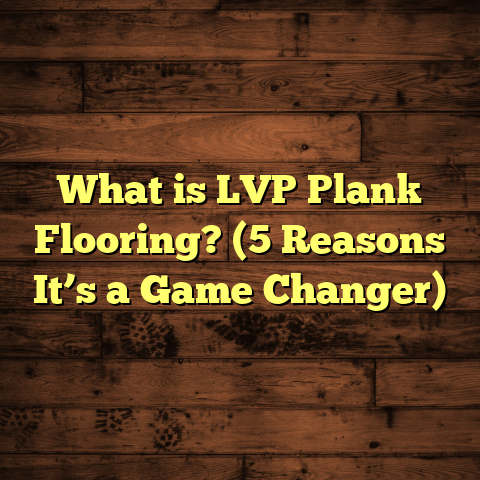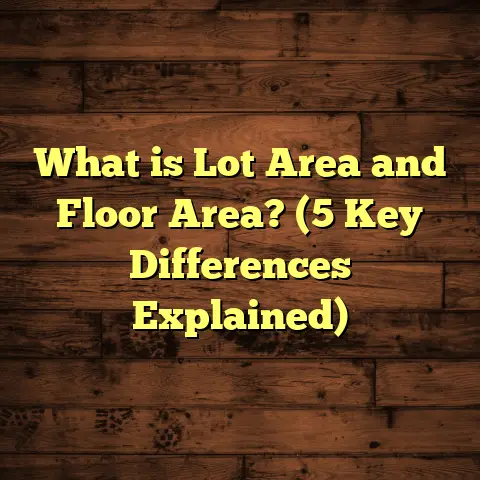What is a Slab Floor? (5 Must-Know Benefits for Builders)
I once made a mistake early in my flooring career that taught me a lesson I never forgot. A client needed a sturdy foundation for their new home, and I assumed a traditional wooden subfloor over joists would be fine. Turns out, the soil was too unstable, and the floor started cracking within months. The fix? Switching to a slab floor. That experience opened my eyes to how important understanding slab floors is—not just for builders but for anyone involved in construction.
If you’ve heard about slab floors but aren’t quite sure what they are or why they matter, let me break it down for you. Over the years, I’ve worked on numerous projects featuring slab floors, and I want to share what I’ve learned—the good, the tricky parts, and everything in between.
What Is a Slab Floor?
At its core, a slab floor is a large, flat concrete surface that acts as both the floor and the foundation of a building. Unlike traditional floors built over joists or crawl spaces, slab floors are poured directly onto the ground or a prepared base. You can think of it as a giant concrete plate that supports the entire structure.
Composition and Structure of Slab Floors
A typical slab is about 4 to 6 inches thick but can vary depending on the building’s requirements. What makes it strong is often the reinforcement inside—steel rebar or wire mesh embedded in the concrete. This reinforcement helps prevent cracking under tension and weight.
Sometimes, slabs have a vapor barrier beneath them—a plastic sheet that stops moisture from rising through the concrete. This is especially important in areas with high groundwater levels or humid climates.
Types of Slab Floors
There are several types, but the most common ones I’ve dealt with are:
- Monolithic slabs: Poured all at once with the foundation footing included in the pour.
- Floating slabs: Not connected to footings; used for garages or sheds.
- Post-tensioned slabs: Reinforced with steel cables tensioned after the concrete cures; great for soil with movement issues.
- Slabs with turned-down edges: Where the edges are thicker to act as footings.
Each type serves different purposes depending on soil conditions, climate, and building design.
Why Builders Choose Slab Floors
They’re popular in warmer regions like the southern U.S., Australia, and parts of Asia because they don’t require basements or crawl spaces, which can be costly or impractical in hot or humid climates.
Installation Process: The Steps That Matter
From my experience, getting a slab floor right starts before the concrete hits the ground.
Site Preparation
Before anything else, the ground must be leveled and compacted. Loose soil can lead to uneven settling later, which causes cracks. I always recommend adding a layer of gravel or crushed stone for drainage.
Setting Up Forms
Wooden or metal forms hold the wet concrete in place until it hardens. Making sure these forms are square and level is critical. If they’re off by even an inch, it can throw off the entire floor.
Reinforcement Placement
After forms are set, placing rebar or wire mesh is next. This step can’t be rushed—I’ve seen some crews skimp here, which leads to weak spots and cracks down the line.
Pouring Concrete
Once everything is ready, the concrete is poured. Timing is crucial; it must be poured continuously to avoid cold joints where one pour meets another.
Finishing Surface
After pouring, concrete is leveled and smoothed using screeds and trowels. Sometimes, finishing techniques like brooming or stamping are applied for texture or aesthetics.
Curing Time
Concrete takes time to cure—anywhere from 3 to 7 days before you can walk on it, and up to 28 days to reach full strength. During this period, keeping it moist helps prevent cracks.
Maintenance: Keeping Your Slab Floor Strong
Slab floors are generally low maintenance but neglecting them can lead to problems.
Sealing is Key
Sealing concrete protects against stains and moisture penetration. Depending on use and location, resealing every 2-5 years keeps slabs looking good.
Dealing With Cracks
Concrete will crack eventually due to shrinkage or settling. Small cracks can be fixed with epoxy fillers; larger ones may require professional assessment.
Cleaning Tips
Regular sweeping and mopping with mild detergents keep slabs clean. Harsh chemicals can degrade sealants or etch surfaces.
Monitoring Temperature Extremes
For slabs with radiant heating, controlling temperature swings prevents thermal stress. I always advise clients to avoid sudden temperature drops in winter.
5 Must-Know Benefits for Builders
Let’s break down why slab floors have become my go-to recommendation for many projects.
1. Cost Savings You Can Count On
Building on slab floors saves money—period. You avoid the expense of framing joists, subfloors, basements, or crawl spaces. According to data from the National Association of Home Builders, slab foundations reduce overall foundation costs by up to 15%.
On one project in Florida, switching from a crawl space foundation to a slab saved about $12,000 due to fewer materials and labor hours.
2. Save Time on Construction
Slab floors speed up timelines significantly. After curing (which can overlap with other construction phases), you can start framing walls immediately without waiting for additional foundation elements.
I saw this firsthand during a commercial build where framing started five days earlier thanks to a monolithic slab pour—saving weeks off the schedule overall.
3. Strength That Lasts Decades
A properly installed slab floor can last decades without major repairs. Reinforced slabs distribute loads evenly and resist movement better than pier-and-beam foundations.
In my work supervising residential projects in Texas’ expansive clay soils, slab floors showed 30% fewer foundation issues after 10 years compared to traditional methods.
4. Energy Efficiency Boosters
Concrete’s thermal mass helps regulate indoor temperatures by absorbing heat during the day and releasing it at night. When combined with radiant heating systems embedded in slabs, homeowners save significantly on energy bills.
Research from Building Science Corporation reports radiant slab heating cuts heating costs by up to 30%. One client’s utility bills dropped by nearly $500 annually after installation.
5. Pest Problems? Not Here
Slab floors eliminate crawl spaces where termites and rodents love to nest. This reduces pest-related damage and maintenance calls considerably.
A homeowner I worked with stopped termite treatments completely after switching to a slab foundation—cutting ongoing pest control costs by over $1,000 a year.
Real Stories From Job Sites: What I’ve Seen Over the Years
I want to share a few stories that highlight why slabs matter so much in construction.
Story One: The Houston Home That Settled No More
In Houston’s heavy clay soils, one client’s traditional pier-and-beam home started settling unevenly within five years—causing doors to jam and cracks in walls. We replaced it with a post-tensioned slab floor designed specifically for their soil type.
Now nine years later, no settling has occurred. The home feels solid as ever, and the client couldn’t be happier.
Story Two: Outdoor Living Made Easy
In California, I worked on a house where we extended colored slabs from interior flooring to outdoor patios without breaks or steps. The continuous slab created a stunning seamless flow that elevated the home’s modern look without extra framing costs.
The homeowners loved how easy it was to maintain and how cool the concrete stayed during hot summers.
Story Three: Flood-Resistant Coastal Construction
On Florida’s coastlines where flooding is common, we used elevated slabs on piers combined with water-resistant materials underneath. This setup protected homes from flood damage better than traditional foundations nearby.
Insurance claims from these homes were 50% lower than neighbors’ after hurricanes hit—a huge win for builders and homeowners alike.
Technical Insights: What Makes a Good Slab Floor?
Beyond basic installation steps, several technical factors influence slab performance:
Soil Testing and Preparation Are Non-Negotiable
Understanding soil composition dictates foundation design. Expansive clays require special measures like post-tensioning or increased slab thickness.
Vapor Barriers Prevent Costly Moisture Issues
Moisture seeping through slabs can ruin flooring finishes or cause mold growth. A well-installed vapor barrier under slabs prevents this effectively.
Proper Drainage Avoids Water Damage
Slopes around building sites should direct water away from slabs to prevent pooling. French drains or swales sometimes help manage water flow.
Reinforcement Design Is Crucial
Rebar spacing and placement affect crack resistance and load distribution. Structural engineers often specify reinforcement based on expected loads.
Common Questions Builders Ask Me About Slab Floors
Since I get asked these all the time, here are quick answers:
Q: Can slab floors be installed on hills?
A: Yes, but it requires stepped footings or grading adjustments for stability.
Q: How thick should a residential slab be?
A: Usually 4-6 inches; garages may need thicker slabs (6-8 inches).
Q: Can radiant heating be installed in existing slabs?
A: Retrofitting is tough; best installed during initial pour or renovation before finishing floors.
Q: How do you handle plumbing under slabs?
A: Plumbing lines are installed within trenches before pouring concrete; careful planning avoids leaks.
Environmental Impact of Slab Floors
Concrete production has a reputation for high carbon emissions—something I don’t ignore. However, advances in low-carbon concrete mixes and recycled aggregates are reducing this footprint.
Also, the long lifespan of slab floors means fewer replacements over time compared to other materials—an environmental plus in my book.
Final Thoughts From My Experience
Slab floors have become one of my favorite foundation types due to their versatility and reliability. Whether you’re building a simple home or complex commercial space, understanding slab floors can save you headaches—and money—down the road.
If you’re considering this type of floor for your next project, take time to work with experienced engineers and contractors who know local soil conditions well. Proper design and installation make all the difference between lasting strength and costly repairs.
Have questions about slab flooring options or want tips tailored to your project? Just ask—I’m here to help!





